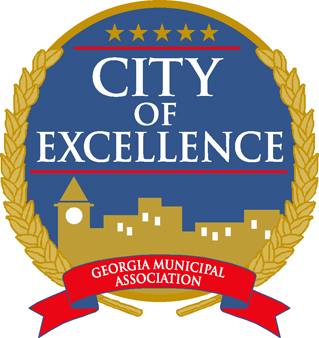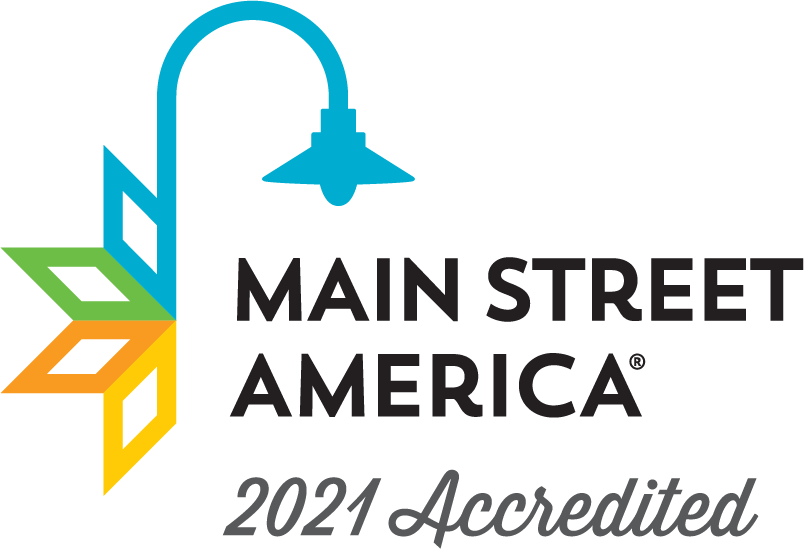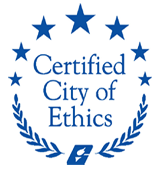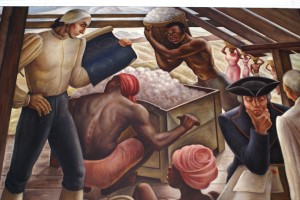
Edna Reindel Mural
“Experimenting with the First Model of the Cotton Gin” was a mural painted by Edna Reindel in 1939 for the Works Progress Administration (WPA). The mural depicts Eli Whitney consulting his plans while he instructs workers on the operation of the cotton gin. Whitney’s invention hugely increased the volume of cotton processed and made the cultivation of cotton extremely lucrative for the American South. Known as one of America’s foremost painters and sculptors, Reindel completed several murals between 1937 and 1942. The mural is located in the annex of the Emanuel County Courthouse and can be viewed during regular Courthouse hours, Mon-Fri., 8:00 am to 5:00 pm. For more information on this mural contact (478) 237-5630
Edenfield House Murals
Historians and art enthusiasts will be thrilled by the 10 hand-painted murals adorning the foyer walls. Scenes of Mount Vernon, the city of Savannah’s seascape, and the Pony Express are poised to greet and astonish all who enter the Edenfield House. While the artist’s name remains unknown, these wall murals were painted during the Works Progress Administration—a project created and funded under President Franklin Delano Roosevelt in 1935. In most cases, two and three single-wall panels are painted to harmonize multiple walls, thus creating a visual masterpiece. These murals are among the largest and most impressive hand-painted wall mural displays from this long-bygone era. The Edenfield House murals can be viewed—by appointment at 426 West Church Street in Swainsboro—by calling the property’s General Manager at (478) 237-3007.
City Hall Mural
The City Hall Mural is one of Swainsboro’s most unique pieces of public artwork. Commissioned in the early 1900’s, the mural depicts six scenes familiar to Emanuel County created by an artist from Atlanta, GA. The mural’s subject matter includes harvesting sap for turpentine, industrial scenes, and scenes of nature and agriculture. The mural is literally sculpted into a concrete wall in the lobby area of City Hall. For more information on the City Hall Mural please contact (478) 237-7025 or visit Monday-Friday, 9:00 am-4:30 pm at 101 West Main Street.

Celebrate the Arts Mural
Located in the heart of downtown, the Celebrate the Arts Mural depicts a variety of visual and performing arts emerging in Swainsboro. Created in 2006 in conjunction with the Arts Emanuel Festival by the Emanuel Artists Guild, the mural is the first of several contemporary public works projects being implemented for downtown Swainsboro. Designed by painters Jean Gray Drake and Neil Kalmanson, the Celebrate the Arts Mural showcases the talents and styles of over five local and regional painters. The mural also relied heavily on public participation with four separate mandalas made up of a hundred community members’ handprints. The first handprint made on the mural was by Mayor Charles Schwabe. The Celebrate the Arts Mural is located on Green Street between West Main Street and Moring Street.
Swainsboro is rich with history. The following list of buildings, homes, and structures are a must-see for those interested in both history and architecture. Buildings with a star beside them are private residences, so please respect the owner’s privacy during your Historic Building Tour of Swainsboro.
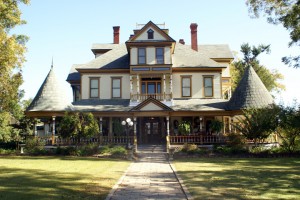
Coleman House
The Coleman House is a picturesque Victorian era mansion. It is an example of an eclectic combination of details from two popular national styles, the Queen Anne and Neoclassical Revival, both commonly used in Georgia during the early 20th Century. Originally built between 1900 and 1904, the Coleman House is also significant as the first house in Emanuel County to have indoor plumbing and electricity. The Coleman House serves as a restaurant and bed and breakfast. The Coleman House is located at 323 North Main Street.
The Edenfield House
Built in 1895, this magnificent home was purchased as the personal residence for the Edenfield family in 1927. The Edenfield family was a prestigious family of great social standing and importance in the City of Swainsboro, Emanuel County, and frankly, the entire State of Georgia. Through the years, H.C. Edenfield was a lawyer, farmer, businessman, banker, and legislator. Next to him for almost five decades, the amazing Mrs. Mabel Edenfield was truly the grande dame of the social icon known as the “Edenfield House”.

In 1984, the home was purchased by Mr. and Mrs. James W. Buckley who—after completing a 10-month total renovation—opened the Edenfield House as a bed and breakfast inn. Their vision was to create “the ultimate in warm, luxurious accommodations.” They hit the bullseye in 1985 when they opened the Edenfield House as a world-class bed and breakfast inn for the very first time! Original wood trim, crystal chandeliers, and gorgeous gilded mirrors all take you back to a “Gone with the Wind” place in time. The Edenfield House boasts nine spacious bedrooms, all with private bathrooms and individually-controlled heat and air conditioning, which are available for overnight accommodations. Visitors may tour the Edenfield House—by appointment at 426 West Church Street in Swainsboro—by calling the property’s General Manager at (478) 237-3007.
* George L. Smith House
George L. Smith, II was one of Emanuel County’s most influential leaders. As a member of the Georgia House of Representatives for 29 years and speaker of that body for 11 years, George L. Smith served the state and his county with great honor and passion. Built between 1938 and 1942, the house was George L. Smith’s main residence until his death in 1973. The house remains in the Smith family and is located at 625 North Main Street.
The Old Dixie Theater
Built in 1933 by William and Fannie Mae Karrh, The Dixie Theater was Swainsboro’s second movie theater. This one screen theater contained lower level and balcony seating and played new movies seven days a week until the 1970’s. Still owned by the Karrh family, the Dixie Theater has since been converted into an antique mall. The building still boasts its original façade and is a definite “Must-See” on your tour of historic buildings in Swainsboro. You can visit the location of the Dixie Theater at 107 North Green Street.
City Hall
The City Hall Building was built in 1908 at the crossroads of Highway 80 and US 1 in downtown Swainsboro. Originally built as Citizens Bank, the building still contains two large safes and original artwork contracted in the 1930’s. The building was converted into City Hall in the 1971 and now houses the Mayor’s Office, the Building Department, Downtown Development, and the City Administrator’s office. During the buildings conversion, the main entrance was changed from the Southwest corner to its current position on West Main Street. The City Hall Building is located at 101 West Main Street and is open Monday-Friday, 9am-4:30pm.
Coca Cola Bottling Plant
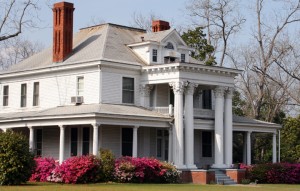
Swainsboro’s second Bottling Plant was built in 1936 to serve four counties in Georgia. The North Main Street Plant bottled Coke and Ginger Ale as Coca Cola was emerging as one of the most popular sodas in America. The facility was managed by C.E. Reed and included Swainsboro’s first elevator, and community meeting rooms that were used by the Kiwanis Club and local bridge clubs. Each year, Mr. Reed oversaw a BBQ for the City of Swainsboro and in the late 1930’s, Mrs. Margaret Mitchell, Pulitzer Prize winning author of Gone with the Wind, was in attendance. The most popular feature of these annual BBQ’s was the “All you can drink Coca Cola.” The Coca Cola Plant is located at 436 North Main Street.
* Old Nora Coleman House
Church Street’s Nora Coleman House (also known as “the Karrh House”) is a grand Greek Revival structure built in 1907. After Ms. Coleman’s death, the house was kept in family and owned by William Henry Flanders and Mattie Moring Mitchell Flanders.The Nora Coleman House of the 1930’s featured a sleeping porch with a covered well, an impressive library, double doors on and a Grecian mural by Mr. Dwoskin of Brown Decorating Company. The house is a private residence that underwent a major restoration that concluded in 2019. The house is located at 416 West Church Street.
Lodge Building
Built in the early 1900’s, the Lodge Building is believed to be Swainsboro’s second City Hall. The building housed the City’s main offices downstairs including the City Jail, Police Station, and a Fire Station. Until 1971, the upstairs was used by local Masonic Lodge. With the purchase of the old Citizen’s Bank Building by the City of Swainsboro, City Hall was relocated to 101 West Main Street and the Lodge Building was sold to Masonic Lodge #244 and renovated in 1973. The Lodge Building is located at 200 West Main Street.
* Old Frank Mitchell House
Built around the beginning of the 20th Century (before 1903), the Old Frank Mitchell house was owned by Judge Frank Mitchell and Luck Coleman Mitchell. The house remained in the Mitchell family until Mrs. Mitchell’s death in 1957. The Old Frank Mitchell House once included thirty acres of land, a barn, and smokehouse. The house once included intricate murals, a parlor, sliding oak doors and a large dining room. Mrs. Mitchell used the thirty acres attached to the house to raise and make everything she ate. Mrs. Mitchell was known in the community for making her own butter which is she sold at the local Sanitary Market. The Old Frank Mitchell House is located at 209 East Pine Street.

